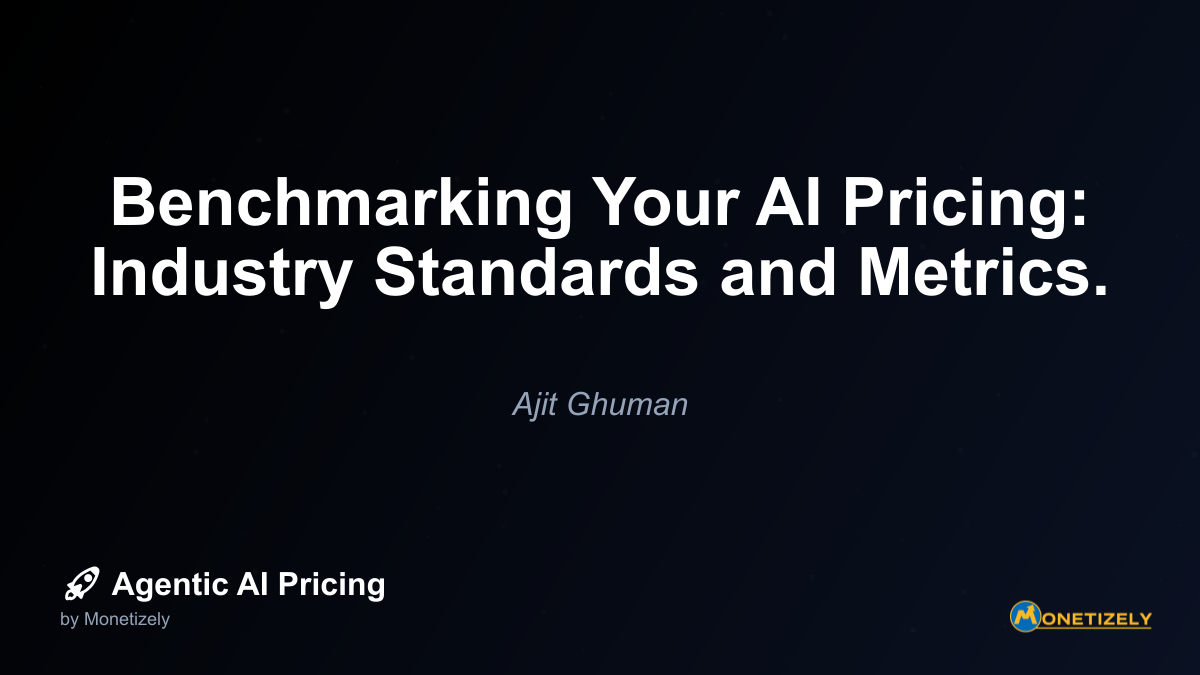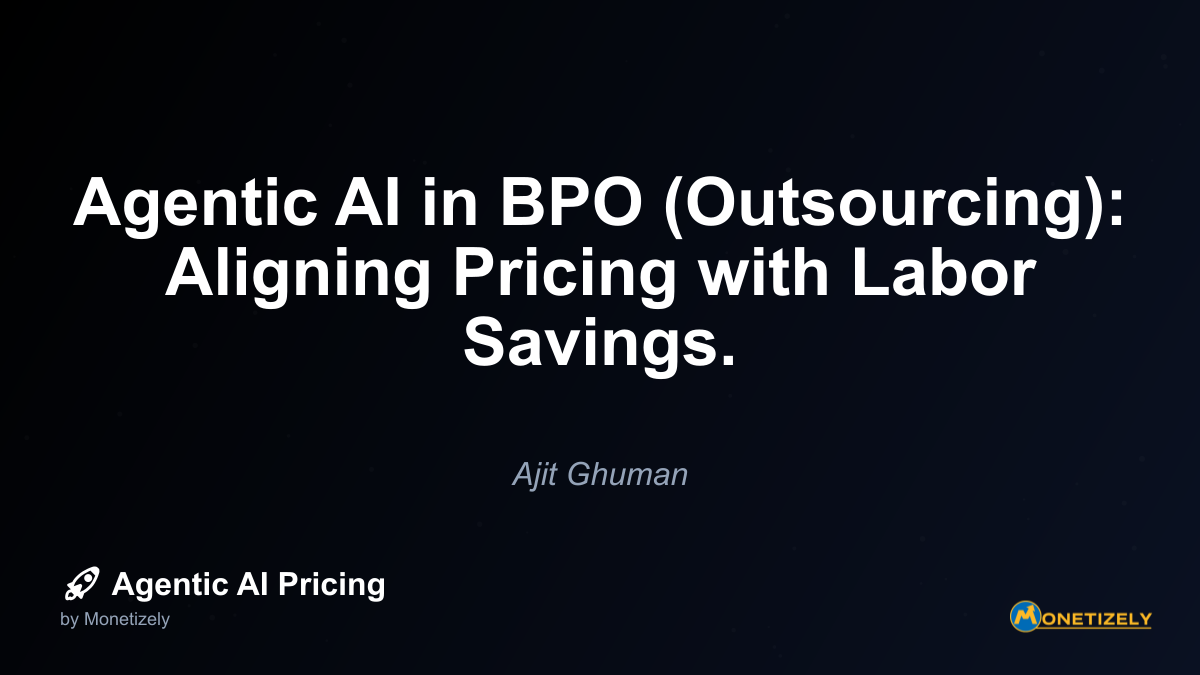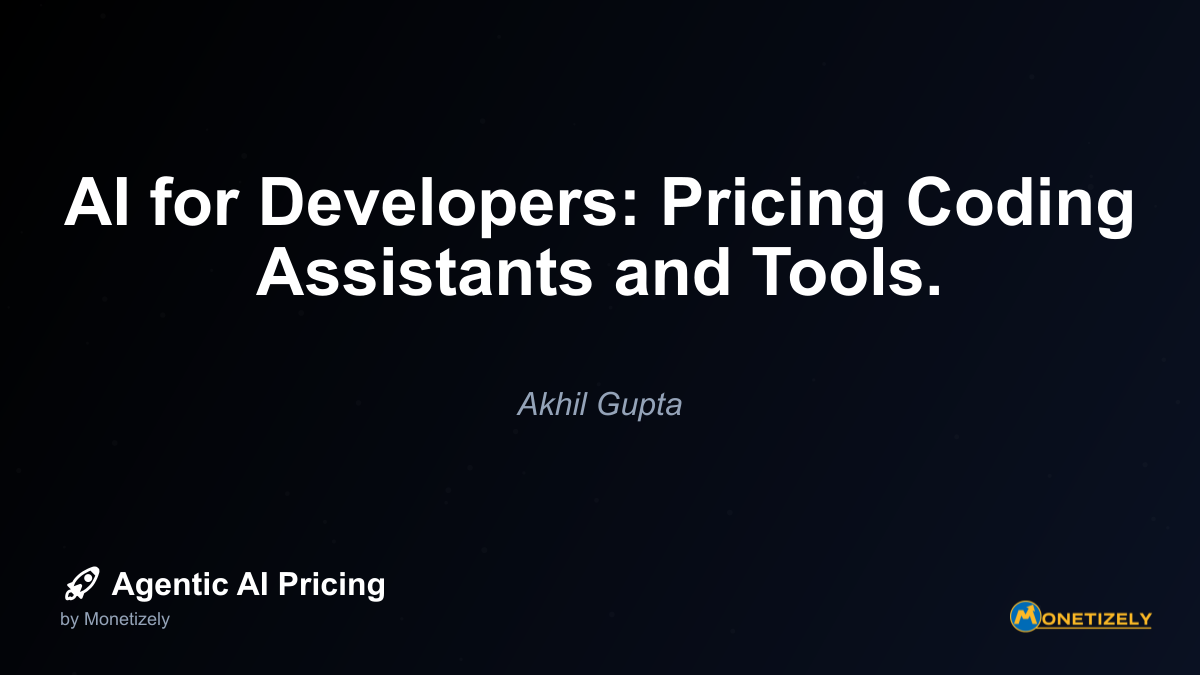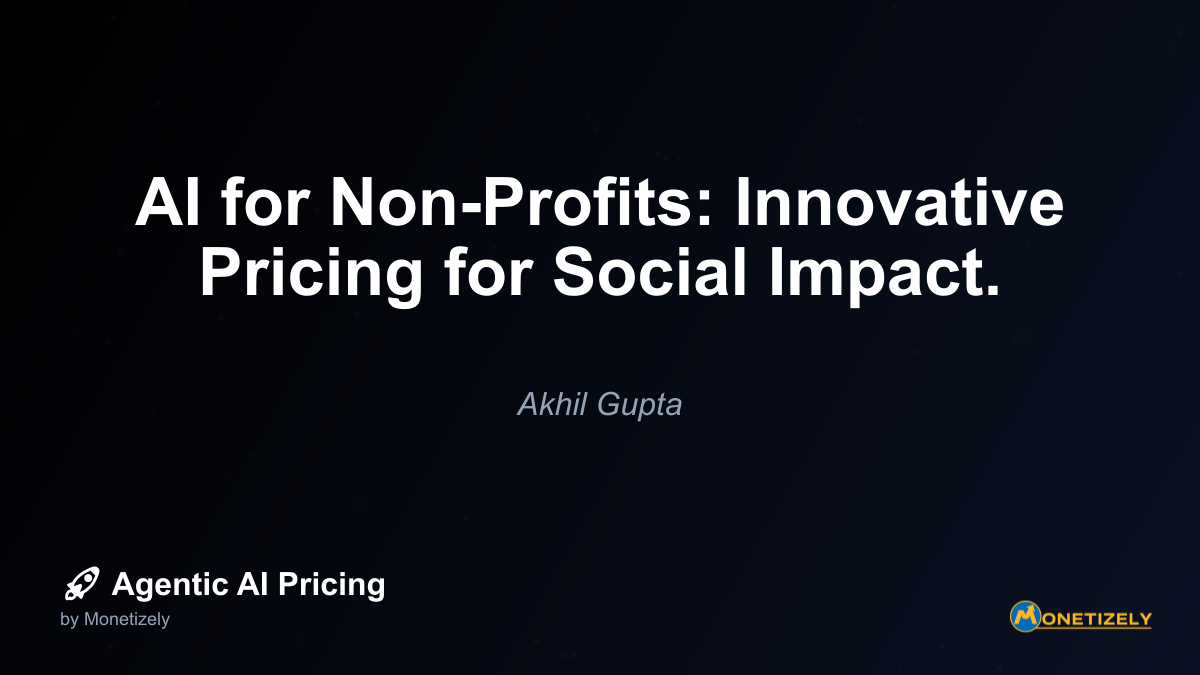· Ajit Ghuman · Industry Insights · 8 min read
Benchmarking Your AI Pricing: Industry Standards and Metrics.
AI and SaaS Pricing Masterclass
Learn the art of strategic pricing directly from industry experts. Our comprehensive course provides frameworks and methodologies for optimizing your pricing strategy in the evolving AI landscape. Earn a professional certification that can be imported directly to your LinkedIn profile.

Benchmarking your AI pricing strategy against industry standards isn’t just a good practice—it’s essential for maintaining competitiveness in today’s rapidly evolving market. As AI capabilities expand and customer expectations shift, understanding where your pricing model stands relative to your peers provides critical insight into potential opportunities and threats.
Why Benchmarking Matters for AI Products
The AI market presents unique pricing challenges compared to traditional software. With development costs often higher and value perception more complex, companies frequently struggle to properly position their AI offerings. Without proper benchmarking, you risk either leaving money on the table with underpriced solutions or pricing yourself out of consideration entirely.
According to recent industry analysis, companies that regularly benchmark their pricing strategies against competitors show 15-20% higher profitability than those that don’t. This performance gap becomes even more pronounced in emerging technology sectors like agentic AI, where pricing models are still evolving and customer value perceptions remain fluid.
Benchmarking isn’t just about comparing price points—it’s about understanding the complete value exchange between your company and customers. This includes examining revenue metrics, conversion patterns, customer acquisition costs, and usage behaviors across your market segment.
Key Metrics to Benchmark in AI Pricing
When evaluating your AI pricing strategy against industry standards, focus on these critical metrics:
1. Revenue Per User (RPU)
RPU represents the average revenue generated by each user of your AI product. This metric provides insight into how effectively you’re monetizing your user base compared to competitors.
For agentic AI products, industry standards for RPU vary significantly by sector:
- Enterprise AI assistants: $75-150 per user monthly
- Consumer-facing AI tools: $15-40 per user monthly
- Specialized industry AI solutions: $200-500+ per user monthly
When benchmarking RPU, segment your analysis by:
- Customer size (enterprise vs. SMB)
- Industry vertical
- Geographic region
- Feature utilization level
Lower-than-average RPU might indicate underpricing or missed upsell opportunities, while significantly higher figures could suggest potential market share vulnerability if competitors deliver comparable value at lower price points.
2. Conversion Rates
Conversion rate benchmarking reveals how effectively your pricing structure and value proposition move prospects through your sales funnel compared to industry norms.
Current benchmarks for AI products show:
- Free-to-paid conversion: 2-5% for consumer applications, 8-15% for business tools
- Trial-to-paid conversion: 15-30% for mainstream AI tools, 30-50% for specialized solutions
- Freemium tier conversion: 3-8% industry-wide
If your conversion rates fall below these benchmarks, consider examining:
- Pricing transparency issues
- Value demonstration gaps
- Friction in the purchase process
- Misalignment between free and paid features
3. Customer Acquisition Cost (CAC) to Lifetime Value (LTV) Ratio
The CAC:LTV ratio measures the relationship between what you spend acquiring customers and the revenue they generate over their lifetime. This metric helps determine if your pricing model supports sustainable growth.
For AI products, healthy benchmarks include:
- B2B AI solutions: LTV should be 3-5x CAC
- Consumer AI products: LTV should be 2-3x CAC
- Enterprise AI platforms: LTV should be 5-7x CAC
When this ratio falls below industry standards, your pricing strategy likely needs adjustment to either increase customer value or reduce acquisition costs.
4. Usage Patterns and Engagement Metrics
Usage benchmarking helps identify whether your pricing aligns with how customers actually use your product compared to competitors.
Key usage metrics to benchmark include:
- Daily/monthly active users (DAU/MAU ratio)
- Feature adoption rates
- API call volumes (for AI services)
- Time spent in application
- Task completion rates
For agentic AI products specifically, measure:
- Agent activation frequency
- Autonomous task completion success rates
- Human intervention frequency
- Processing time for standard tasks
Understanding these patterns helps identify opportunities to align your pricing model with actual usage behavior, potentially shifting toward consumption-based or value-based pricing if appropriate.
Sources for Benchmarking Data
Collecting reliable benchmarking data for AI pricing requires multiple information sources:
1. Industry Reports and Surveys
Several organizations publish regular reports on AI pricing trends:
- Gartner’s annual AI market analysis
- OpenAI’s ecosystem pricing studies
- PwC’s AI pricing benchmark reports
- Forrester’s AI market wave reports
These reports typically segment data by industry vertical, company size, and geographic region, allowing for more precise comparisons.
2. Competitor Analysis
Direct competitor analysis provides the most relevant benchmarking data. Approaches include:
- Subscribing to competitor services to analyze pricing structures
- Reviewing public pricing pages and conducting feature comparisons
- Analyzing competitor financial disclosures for revenue insights
- Speaking with customers who have evaluated competing solutions
When conducting this analysis, create a structured comparison matrix that maps features, limitations, and pricing components across competitors.
3. Customer Feedback and Win/Loss Analysis
Your customers and prospects offer valuable benchmarking insights through:
- Win/loss interviews after sales processes
- Customer advisory boards
- User surveys comparing your pricing to alternatives
- Exit interviews with churned customers
These sources often reveal perception gaps between your pricing and what customers consider industry standard.
4. Industry Partnerships and Communities
Participate in industry groups focused on AI business models:
- AI industry consortiums
- Pricing professional networks
- Technology vendor alliances
- Academic research partnerships
These communities often share anonymized benchmarking data that would otherwise be difficult to obtain.
How to Conduct an Effective Benchmarking Process
Follow these steps to implement a thorough AI pricing benchmarking initiative:
1. Define Your Benchmarking Scope
Begin by clearly defining:
- Which metrics matter most for your specific AI product
- Which competitors or adjacent solutions to include
- What timeframe to analyze (quarterly, annually)
- Which customer segments to focus on
This scoping exercise ensures your benchmarking delivers actionable insights rather than overwhelming data.
2. Collect and Normalize Data
Gather data from the sources mentioned above, then normalize it to account for:
- Different company sizes and growth stages
- Regional pricing variations
- Feature set differences
- Varying business models
Without proper normalization, benchmarking can lead to misleading conclusions about your competitive position.
3. Identify Gaps and Opportunities
Analyze the normalized data to identify:
- Pricing components where you significantly deviate from standards
- Metrics where you outperform or underperform peers
- Emerging pricing models gaining traction in your segment
- Customer segments where your pricing position is strongest/weakest
Document these findings in a structured format that highlights both immediate concerns and longer-term strategic opportunities.
4. Develop Action Plans
Convert benchmarking insights into concrete action plans:
- Short-term tactical adjustments to address immediate gaps
- Medium-term strategic shifts in pricing model or structure
- Long-term positioning changes to anticipate market evolution
For each action, establish clear ownership, timelines, and expected impact on key metrics.
5. Implement Continuous Benchmarking
Establish a regular cadence for benchmarking activities:
- Quarterly reviews of key competitive pricing changes
- Semi-annual deep dives into comprehensive benchmarking
- Annual strategic pricing reviews incorporating benchmark data
This continuous approach ensures pricing decisions remain informed by current market conditions rather than outdated assumptions.
Common Benchmarking Pitfalls to Avoid
When benchmarking your AI pricing, watch for these common mistakes:
1. Focusing Solely on Price Points
Many companies limit benchmarking to comparing list prices, missing the broader value exchange. Instead, benchmark the complete pricing model, including:
- Packaging structure
- Discount strategies
- Contract terms
- Implementation and support costs
- Total cost of ownership
This holistic approach reveals more meaningful competitive insights than simple price comparisons.
2. Ignoring Segment-Specific Benchmarks
Broad industry benchmarks often mask important segment variations. Always segment benchmarking data by:
- Customer size
- Industry vertical
- Geographic region
- Use case complexity
What appears as underpricing in one segment might actually be overpricing in another more price-sensitive segment.
3. Overlooking Indirect Competitors
For AI products, competition often comes from unexpected sources:
- In-house development teams
- Open-source alternatives
- Adjacent solutions with expanding AI capabilities
- New market entrants with disruptive models
Comprehensive benchmarking must include these indirect competitors that influence customer expectations and willingness to pay.
4. Reacting Too Quickly to Benchmarking Data
While benchmarking provides valuable insights, avoid knee-jerk reactions to data points. Instead:
- Validate findings through multiple sources
- Test potential pricing changes with small customer segments
- Consider the strategic implications of matching competitor pricing
- Evaluate whether differentiation might be more valuable than conformity
Sometimes, deviating from industry benchmarks represents a strategic advantage rather than a problem to fix.
Case Study: Successful AI Pricing Benchmarking
Consider how one mid-sized AI document processing company used benchmarking to transform their pricing strategy:
Initially, the company priced their solution at a flat $500 monthly subscription regardless of document volume. Benchmarking revealed:
- Competitors had moved to usage-based models averaging $0.15-0.25 per processed document
- Enterprise customers were processing 5,000+ documents monthly (worth $750-1,250 under competitive pricing)
- Small business customers processed only 1,000-2,000 documents (worth $150-500)
Based on this benchmarking, the company:
- Implemented tiered, usage-based pricing with volume discounts
- Created a lower-priced entry tier for small businesses
- Added premium features for enterprise customers
- Established clear upgrade paths between tiers
The results:
- Revenue increased 35% within six months
- Customer acquisition improved 22% in the small business segment
- Churn decreased from 8% to 5% quarterly
- Competitive win rates improved from 40% to 65%
This case demonstrates how effective benchmarking identifies opportunities to align pricing with both market expectations and actual product value.
Implementing Benchmarking in Your Organization
To establish effective pricing benchmarking capabilities:
1. Assign Clear Ownership
Designate specific responsibility for pricing benchmarking to either:
- A dedicated pricing team
- Product management with pricing expertise
- A cross-functional pricing committee
Without clear ownership, benchmarking typically becomes an inconsistent, reactive exercise.
2. Invest in Benchmarking Tools
Consider investing in:
- Competitive intelligence platforms
- Market data subscriptions
- Pricing optimization software
- Customer feedback systems
These tools streamline data collection and analysis, making benchmarking more efficient and accurate.
3. Create a Benchmarking Calendar
Establish a regular schedule for:
- Weekly monitoring of competitor pricing changes
- Monthly review of key pricing metrics
- Quarterly comprehensive benchmarking analysis
- Annual strategic pricing review
This calendar approach ensures benchmarking becomes a proactive discipline rather than a reactive response to competitive threats.
4. Build Internal Benchmarking Expertise
Develop internal capabilities through:
- Pricing strategy training
- Competitive analysis workshops
- Benchmarking methodology documentation
- Cross-functional involvement in benchmarking activities
As AI pricing models continue evolving rapidly, this internal expertise becomes increasingly valuable.
Conclusion: Beyond Benchmarking to Leadership
While benchmarking provides essential context for AI pricing decisions, the most successful companies use these insights as a foundation for leadership rather than simply matching industry standards.
The most effective approach combines:
- Rigorous benchmarking to understand current market positioning
- Customer research to identify unmet needs and willingness to pay
- Product differentiation to justify premium positioning where appropriate
- Pricing innovation to capture value in ways competitors haven’t discovered
By balancing benchmarking insights with strategic differentiation, you position your AI product for sustainable growth rather than commoditization.
As the AI landscape continues evolving, maintaining a structured benchmarking practice ensures your pricing strategy remains both competitive and value-maximizing. Regular assessment against industry standards provides the foundation for informed pricing decisions that drive both market share and profitability.
Remember that in rapidly evolving markets like AI, today’s benchmarks may become tomorrow’s outdated practices. The most successful companies use benchmarking not just to match current standards, but to anticipate where the market is heading and position their pricing accordingly.
Co-Founder & CEO
Ajit is the author of Price To Scale, a top book on SaaS Pricing and is the Founder of Monetizely. Ajit has led and worked in pricing and product marketing at firms like Twilio, Narvar and Medallia. His work has been featured in Forbes and VentureBeat. Ajit regularly consults with software companies from Seed stage to post-IPO on pricing strategy. Ajit is also a highly-rated co-instructor for 'The Art of SaaS Pricing and Monetization' on Maven.
Pricing Strategy Audit
Let our experts analyze your current pricing strategy and identify opportunities for improvement. Our data-driven assessment will help you unlock untapped revenue potential and optimize your AI pricing approach.




